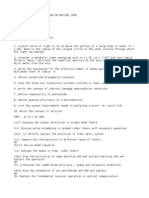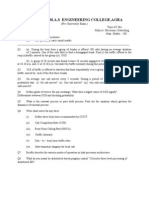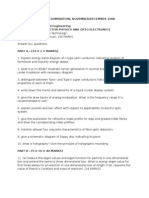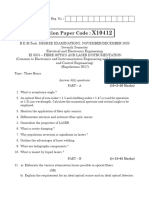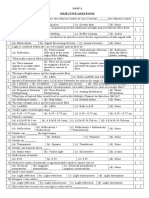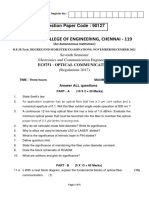B - (E-? TC 1: N.S.: (1) Question No.1 Is
B - (E-? TC 1: N.S.: (1) Question No.1 Is
Uploaded by
ulkrishtCopyright:
Available Formats
B - (E-? TC 1: N.S.: (1) Question No.1 Is
B - (E-? TC 1: N.S.: (1) Question No.1 Is
Uploaded by
ulkrishtOriginal Description:
Original Title
Copyright
Available Formats
Share this document
Did you find this document useful?
Is this content inappropriate?
Copyright:
Available Formats
B - (E-? TC 1: N.S.: (1) Question No.1 Is
B - (E-? TC 1: N.S.: (1) Question No.1 Is
Uploaded by
ulkrishtCopyright:
Available Formats
P4-Exam.
-09-275
..
B -( E-?<TC t ~-e~
O,Fr~
(3 Hours)
~.
tf-~
~1
\, q\-v)
or
r\-Q
Con. 3142-09.
(REVISED COURSE)
VR-4272
[Total Marks: 100
N.S.: (1) Question No.1 is compulsory.
(2) Answer any four questions out of remaining six questions. 1. Answer the following in brief :(a) Discuss the basic block diagram of optical communication system. (b) What are direct and indirect semiconductors? Which types are suitable to be used as optical sources and detectors.
5 5 5 5
(c). How does the optical signal propagate through the GIF. (d) What is the difference between coherent and non-coherent optical transmission?
'-
2.
(a) . Explain the 'Different Modes' that can be supported by an optical fiber. 10 (b) Using simple ray theory concept, discuss the transmission of light through single 10 mode fiber. What is the major advantage of this type of fiber? the comment. (b) List the important factors responsible for power loss in optical fiber. Explain each 10 factor briefly.
3. (a) 'Optical signal distortion limits the information carrying capacity of the fiber' Justify 10
4.
(a)
What are the general requirements of a good optical source? Describe the 10 technique used to give both electrical and optical confinement in injection lasers. (b) Draw the structure of APD alongwith electrical field profile that exist in the various 10 regions. Explain its working and also explain why it is also called RAPD.
5. (a) Describe two methods of splicing individual fibers together. What are some 10
(b) 6. advantages and disadvantages of each method? Discuss a popular non-destructive technique for attenuation measurement. 10
Describe three methods of preform fabrication. Include starting materials, heat sources, 20 fabrication temperatures used and the technique used to make the preform for-each method.
Write short notes on any four :-
7.
20
(a) (b) (c) (d) (e)
Rise time budget Measurement of dispersion Radiative losses in optical fiber. PIN diode Double heterogenous LED.
".
You might also like
- (3 Hours) : :JO:9p-kett! (''I (Ornrn (Revised Course)Document1 page(3 Hours) : :JO:9p-kett! (''I (Ornrn (Revised Course)Pranjal GangurdeNo ratings yet
- OpfDocument5 pagesOpfshukur76No ratings yet
- Optical Communications: Code: R7420401Document1 pageOptical Communications: Code: R7420401Reddy Kiran KDNo ratings yet
- Ece 311Document2 pagesEce 311MEHEDI HASANNo ratings yet
- EC1402 Optical Communication Nov Dec 2007Document3 pagesEC1402 Optical Communication Nov Dec 2007Subramanian VenkatesanNo ratings yet
- Annauniversity Optical Communication Question PaperDocument7 pagesAnnauniversity Optical Communication Question PaperDeepakNo ratings yet
- Main Y4 SemII Fiber Optic Communication - 2013 - 3Document17 pagesMain Y4 SemII Fiber Optic Communication - 2013 - 3sohaibNo ratings yet
- 19Document4 pages19Reddy Kiran KD0% (1)
- Fiber Optic Communication (Ecen 4142)Document4 pagesFiber Optic Communication (Ecen 4142)ks.shubham22082001No ratings yet
- 2015 OptoDocument1 page2015 OptoRishiNo ratings yet
- ES PaperDocument22 pagesES PaperRaghu Nath SinghNo ratings yet
- Ofc 2008Document3 pagesOfc 2008aggerssiveNo ratings yet
- r7420401 Optical CommunicationsDocument4 pagesr7420401 Optical CommunicationsDilip Kumar CNo ratings yet
- Ect413 CDocument3 pagesEct413 CmpfardeenNo ratings yet
- I A) B) 2 A) B) If 3 A) B) C) : Unitvnnsifv''.. Examination (R&S)Document2 pagesI A) B) 2 A) B) If 3 A) B) C) : Unitvnnsifv''.. Examination (R&S)Adithyan JNo ratings yet
- Ec1402 Optical CommunicationDocument3 pagesEc1402 Optical CommunicationsubhazNo ratings yet
- qq8329 ALLDocument2 pagesqq8329 ALLravogis600No ratings yet
- Ect413 ADocument3 pagesEct413 AmpfardeenNo ratings yet
- Set No. 1Document5 pagesSet No. 1rajlahariNo ratings yet
- Ofc Set 1Document2 pagesOfc Set 1Devendra Pratap SinghNo ratings yet
- C G1048 Pages: 2: Answer Any Two Full Questions, Each Carries 15 MarksDocument2 pagesC G1048 Pages: 2: Answer Any Two Full Questions, Each Carries 15 MarksAdithyan JNo ratings yet
- PH 136 - Semiconductor Physics and Opto ElectronicsDocument3 pagesPH 136 - Semiconductor Physics and Opto ElectronicssubhazNo ratings yet
- Eee Auc 2017 Ei8075 2Document2 pagesEee Auc 2017 Ei8075 2syed1188No ratings yet
- Optical Communication 2008Document2 pagesOptical Communication 2008Thamil ValluvanNo ratings yet
- (Schaum's Outline Series) Hwei Hsu-Schaum's Outline of Theory and Problems of Probability, Random Variables, and Random Processes-McGraw-Hill (1997)Document4 pages(Schaum's Outline Series) Hwei Hsu-Schaum's Outline of Theory and Problems of Probability, Random Variables, and Random Processes-McGraw-Hill (1997)SalmaanCadeXaaji100% (1)
- UNIT-1 Objective QuestionsDocument15 pagesUNIT-1 Objective Questionshyndavi0% (1)
- Optical CommunicationsDocument8 pagesOptical CommunicationsBhargav MushiniNo ratings yet
- PtuDocument2 pagesPtuPanavNo ratings yet
- Question Paper Code:: Reg. No.Document3 pagesQuestion Paper Code:: Reg. No.karthick VijayanNo ratings yet
- AP SBTET V Sem Optical Fibre Communication C14 Mar-Apr 2019 QPDocument2 pagesAP SBTET V Sem Optical Fibre Communication C14 Mar-Apr 2019 QPalinisamaryam1No ratings yet
- 2022 May ETC Optical CommunicationDocument2 pages2022 May ETC Optical CommunicationHussain BarwahwalaNo ratings yet
- Model PaperDocument4 pagesModel PaperP S Pooja SreeNo ratings yet
- Optical Communication EEC-701Document4 pagesOptical Communication EEC-701abhishek1028No ratings yet
- EC2402 OCN Nov 2012 QP PDFDocument3 pagesEC2402 OCN Nov 2012 QP PDFtrichy1783No ratings yet
- QP - Optical Fiber CommunicationDocument2 pagesQP - Optical Fiber CommunicationmuraliNo ratings yet
- C G192048 Pages:2: Answer Any Two Full Questions, Each Carries 15 MarksDocument2 pagesC G192048 Pages:2: Answer Any Two Full Questions, Each Carries 15 MarksAdithyan JNo ratings yet
- Optical CommunicationDocument13 pagesOptical CommunicationkulamangalamNo ratings yet
- ONS Sample Question PaperDocument4 pagesONS Sample Question PaperRaashidNo ratings yet
- Code: 9A10804 B.Tech IV Year II Semester (R09) Regular Examinations, March/April 2013Document4 pagesCode: 9A10804 B.Tech IV Year II Semester (R09) Regular Examinations, March/April 2013Reddy Kiran KDNo ratings yet
- Code: 9A04702 B.Tech IV Year I Semester (R09) Supplementary Examinations June/July 2014Document1 pageCode: 9A04702 B.Tech IV Year I Semester (R09) Supplementary Examinations June/July 2014Reddy Kiran KDNo ratings yet
- 161111-161005-Optical Communication PDFDocument2 pages161111-161005-Optical Communication PDFVanagara BharatNo ratings yet
- Ec-404 Id (Ao329)Document2 pagesEc-404 Id (Ao329)Harshita SinghNo ratings yet
- R7420401 Optical CommunicationsDocument1 pageR7420401 Optical CommunicationsReddy Kiran KDNo ratings yet
- O P T I C A L Communicai-Ion Systeivis: Total No. of Paees: A2 O F Questions: 08Document2 pagesO P T I C A L Communicai-Ion Systeivis: Total No. of Paees: A2 O F Questions: 08wert21No ratings yet
- Electronics & Communication Engineering R13 Iv-I Elective Ii Optical Communications (Rt4104A) Previous End Examination Questions (R13 & R10)Document7 pagesElectronics & Communication Engineering R13 Iv-I Elective Ii Optical Communications (Rt4104A) Previous End Examination Questions (R13 & R10)jaganmohanrsNo ratings yet
- EC6702 OCN_R2013_QPsDocument27 pagesEC6702 OCN_R2013_QPsPraghashrajaNo ratings yet
- B.Tech IV Year II Semester (R09) Regular & Supplementary Examinations April 2016Document1 pageB.Tech IV Year II Semester (R09) Regular & Supplementary Examinations April 2016Reddy Kiran KDNo ratings yet
- Eeng 292Document2 pagesEeng 292osiriwalterNo ratings yet
- Parul Institute Engineering & Technology Electronics and Communication) Class: M. E 2 SemecDocument4 pagesParul Institute Engineering & Technology Electronics and Communication) Class: M. E 2 SemecDonika MarkandeNo ratings yet
- B.Tech IV Year II Semester (R07) Supplementary Examinations April 2016Document1 pageB.Tech IV Year II Semester (R07) Supplementary Examinations April 2016Reddy Kiran KDNo ratings yet
- Cpec 5308 Communication Engineering 2008Document2 pagesCpec 5308 Communication Engineering 2008Niranjan BeheraNo ratings yet
- Optical Fibre CommunicationDocument4 pagesOptical Fibre Communicationhajafarook0% (1)
- OC QPDocument4 pagesOC QPrubanraj r (RA1811201010009)No ratings yet
- 2020-09-14SupplementaryEC405EC405-D - Ktu QbankDocument2 pages2020-09-14SupplementaryEC405EC405-D - Ktu QbankAdithyan JNo ratings yet
- OWC Question bankDocument4 pagesOWC Question banktejukbbNo ratings yet
- Ons QB Final 1Document10 pagesOns QB Final 1harshy0816No ratings yet
- Gujarat Technological UniversityDocument2 pagesGujarat Technological UniversityNehal QadriNo ratings yet
- Stucor Qp-Ec8751Document6 pagesStucor Qp-Ec8751diamond puppyNo ratings yet
- 6050r09-Optical Communications TechnologyDocument1 page6050r09-Optical Communications TechnologyGirija VaniNo ratings yet
- Organic Light-Emitting Transistors: Towards the Next Generation Display TechnologyFrom EverandOrganic Light-Emitting Transistors: Towards the Next Generation Display TechnologyNo ratings yet
- Curriculum VitaeDocument3 pagesCurriculum VitaeulkrishtNo ratings yet
- Starting Over Guide StanfordDocument17 pagesStarting Over Guide StanfordulkrishtNo ratings yet
- World Rankings For Engineering & TechnologyDocument1 pageWorld Rankings For Engineering & TechnologyulkrishtNo ratings yet
- Career in AcademiaDocument4 pagesCareer in AcademiaulkrishtNo ratings yet
- Adult Literacy ProgrammeDocument3 pagesAdult Literacy Programmeulkrisht100% (1)
- Why Submit Why Publish Why ReviewDocument3 pagesWhy Submit Why Publish Why ReviewulkrishtNo ratings yet





